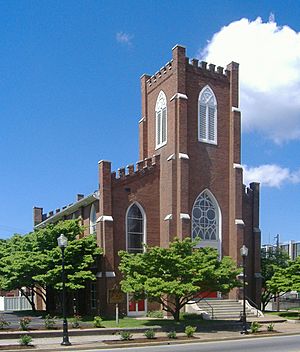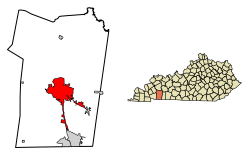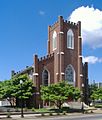Hopkinsville, Kentucky facts for kids
Quick facts for kids
Hopkinsville, Kentucky
|
|
|---|---|

Hopkinsville First Presbyterian Church
|
|

Location of Hopkinsville in Christian County, Kentucky.
|
|
| Country | United States |
| State | Kentucky |
| County | Christian |
| Established | 1804 |
| Incorporated | 1853 |
| Named for | United States Representative Samuel Hopkins |
| Area | |
| • Total | 31.96 sq mi (82.79 km2) |
| • Land | 31.83 sq mi (82.44 km2) |
| • Water | 0.14 sq mi (0.35 km2) |
| Elevation | 528 ft (161 m) |
| Population
(2020)
|
|
| • Total | 31,180 |
| • Estimate
(2022)
|
30,927 |
| • Density | 979.61/sq mi (378.23/km2) |
| Time zone | UTC−6 (CST) |
| • Summer (DST) | UTC−5 (CDT) |
| ZIP code |
42240
|
| Area code(s) | 270 & 364 |
| FIPS code | 21-37918 |
| GNIS feature ID | 0494550 |
Hopkinsville is a city in Kentucky, United States. It is the main city and county seat of Christian County. In 2020, about 31,180 people lived there.
Contents
History of Hopkinsville
How Hopkinsville Started
The land where Hopkinsville now stands was first claimed in 1796 by Bartholomew Wood. He was given this land for his service in the American Revolution. He and his wife, Martha Ann, moved here from Tennessee. They built a few cabins before settling down.
In 1797, the Woods gave 5 acres of their land to create the government center for Christian County. By 1798, a courthouse and jail were built. The community tried to name itself "Elizabeth" after the Woods' oldest daughter. However, another town already had that name.
So, in 1804, the town was officially named "Hopkinsville." It was named after Samuel Hopkins. He was a veteran and a state representative from a nearby county.
Hopkinsville was home to private schools for many years. Later, it had colleges like South Kentucky College (started in 1849) and Bethel Female College (started in 1854). Since 1854, the Western State Hospital, a hospital for mental health, has been located here.
Hopkinsville During the Civil War
The American Civil War caused big disagreements in Christian County. Many people in Hopkinsville and Christian County supported the Confederate side. They formed groups like the "Oak Grove Rangers."
Jefferson Davis, who was the president of the Confederate States, was born near here. His birthplace is now in Todd County, Kentucky. Local business owners and plantation owners gave money and supplies to the South.
After Confederate forces left for Tennessee, the Union army set up Camp Joe Anderson in 1862. Soldiers trained there and joined Union regiments. James S. Jackson, a lawyer from Hopkinsville, fought for the Union. He died in battle in October 1862.
Hopkinsville was taken over by Confederate and Union forces many times. In December 1864, Confederate troops captured the town. They burned down the Christian County courthouse, which the Union army was using as a barracks.
Tobacco Farming and the Night Riders
The first railroad came to Hopkinsville in 1868. This helped connect the city to other towns. More railroads arrived later, making it easier to transport goods.
Tobacco from the "Black Patch region" was very popular in Europe. In 1904, tobacco farmers formed a group called the Dark Tobacco District Planters' Protective Association. They wanted to fight against a large company that was lowering the prices they paid for tobacco.
The farmers' group tried to get everyone to stop selling tobacco to this company. But some farmers still sold their tobacco. This led to a secret group called the "Silent Brigade," also known as the the Night Riders. They were not connected to the Ku Klux Klan.
On December 7, 1907, about 250 masked Night Riders took over Hopkinsville's police station. They cut off all communication with the outside world. They targeted tobacco executives and city officials who worked with farmers not in their group. Three tobacco warehouses were burned down.
A tobacco broker later wrote that it was hard to catch and punish the Night Riders. They wore masks and promised not to tell anyone what they knew. This made it very difficult to get evidence against them.
Tornadoes in Hopkinsville
On April 2, 2006, a strong tornado hit parts of Hopkinsville. It damaged 200 homes and injured 28 people. Many businesses, trees, and power lines were also damaged. This caused power outages in the city.
On January 1, 2022, another tornado struck Hopkinsville. It ripped the roof off a gas station and destroyed its pumps. A church also lost parts of its roof. This was the first confirmed tornado of 2022.
On March 31, 2023, strong winds up to 90 miles per hour damaged downtown Hopkinsville. The upper floor of a restaurant was lifted off, and the city's clock tower was damaged.
Geography of Hopkinsville
Hopkinsville is located south of the center of Christian County. It is about 35 miles north of Madisonville and 35 miles east of Russellville. Clarksville, Tennessee, is about 26 miles to the south.
The city covers a total area of about 31.96 square miles. Most of this area is land, with a small amount of water.
Climate in Hopkinsville
Hopkinsville has a humid subtropical climate. This means it has hot, humid summers and cool winters. It gets a lot of rain throughout the year. Snowfall is usually light and does not happen very often.
People of Hopkinsville
| Historical population | |||
|---|---|---|---|
| Census | Pop. | %± | |
| 1810 | 131 | — | |
| 1830 | 1,263 | — | |
| 1840 | 1,581 | 25.2% | |
| 1860 | 2,289 | — | |
| 1870 | 3,136 | 37.0% | |
| 1880 | 4,229 | 34.9% | |
| 1890 | 5,833 | 37.9% | |
| 1900 | 7,280 | 24.8% | |
| 1910 | 9,419 | 29.4% | |
| 1920 | 9,696 | 2.9% | |
| 1930 | 10,746 | 10.8% | |
| 1940 | 11,724 | 9.1% | |
| 1950 | 12,526 | 6.8% | |
| 1960 | 19,465 | 55.4% | |
| 1970 | 21,395 | 9.9% | |
| 1980 | 27,318 | 27.7% | |
| 1990 | 29,809 | 9.1% | |
| 2000 | 30,089 | 0.9% | |
| 2010 | 31,577 | 4.9% | |
| 2020 | 31,180 | −1.3% | |
| 2022 (est.) | 30,927 | −2.1% | |
| U.S. Decennial Census | |||
In 2010, there were 31,577 people living in Hopkinsville. About 62.6% of the people were White, and 31.9% were African American. About 3.5% of the people were of Hispanic or Latino origin.
There were 12,174 households in the city. About 32.4% of these households had children under 18 living with them. The average household had 2.39 people.
The population was spread out by age. About 26.4% were under 18 years old. The median age was 35 years. For every 100 females, there were about 87.9 males.
In 2020, the estimated population of Hopkinsville was 30,683. The average household income was $39,743.
Clarksville Metropolitan Area
Hopkinsville is part of the Clarksville, Tennessee–Kentucky Metropolitan Statistical Area. Clarksville is about 15 miles south of Hopkinsville. This area includes Montgomery and Christian counties, and later Stewart and Trigg counties were added. In 2007, the population of this metropolitan area was estimated to be 261,816 people.
Industries in Hopkinsville
Hopkinsville is home to many different businesses and industries. Over 50 companies are part of the local industrial community. These companies offer various services and make many different products.
There are nine Japanese companies in Hopkinsville. There are also companies from Germany, Spain, Canada, and Italy.
The Western State Hospital is a hospital for mental health. It was started in 1854. In 2004, it had 220 patients and employed 650 workers. This hospital is listed on the National Register of Historic Places.
Hopkinsville used to be the main place for Ebonite International. This was one of the oldest and largest companies that made bowling balls. Ebonite owned several famous brands like Hammer, Columbia 300, and Track. The Hopkinsville factories made 60% of the world's bowling balls. However, the company closed its Hopkinsville plants in 2019.
Farming and Agriculture
Hopkinsville and Christian County have a long history of farming. This goes back to the first settlements in the 1790s. The area is a strong leader in growing corn, winter wheat, soybeans, and tobacco.
In 2007, Christian County was ranked:
- #1 for crops in terms of money earned
- #1 for winter wheat
- #2 for corn
- #3 for dark fired tobacco
- #4 for soybeans
Other important crops include burley tobacco and hay. The county also raises cattle and produces milk. Christian County is the second largest county in Kentucky by area. It has about 1,150 farms with over 300,000 acres of farmland.
Farming has become very technical. Farmers in Christian County understand the need for ongoing education. They learn about new machinery, fertilizers, chemicals, and good farming practices. This helps Christian County remain a leader in agriculture.
The Hopkinsville Community College has a special center for agricultural classes. High schools in the area have FFA classes with over 200 members. The local 4-H group is also very active, helping over a thousand members.
The Chamber of Commerce has an Agri-Business Committee. This committee promotes "Ag Week" twice a year. They honor local farmers in different categories. They also give scholarships to students who want to study agriculture in college.
Top Employers in Hopkinsville
Here are the top employers in Hopkinsville as of 2020:
| # | Employer | # of Employees |
|---|---|---|
| 1 | Fort Campbell Army Post | 4,469 |
| 2 | Christian County Board of Education | 1,326 |
| 3 | Martinrea | 900 |
| 4 | Walmart Distribution Center 6066 | 884 |
| 5 | T.RAD North America | 825 |
| 6 | Jennie Stuart Medical Center | 808 |
| 7 | Western State Psychiatric Hospital | 757 |
| 8 | TeleTech Services Corporation | 671 |
| 9 | Grupo Antolin Kentucky Inc. | 568 |
| 10 | TG Automotive Sealing Kentucky | 420 |
Transportation in Hopkinsville
Roads and Highways
Hopkinsville has several major roads passing through it. These include US 41, US 41A, US 68, and Interstate 169. A four-lane bypass road goes almost completely around the city.
An extension of Interstate 169 was completed in 2011. This road now connects the city to Interstate 24 near Fort Campbell.
Air Travel
For commercial flights, people in Hopkinsville use Nashville International Airport. Hopkinsville also has its own airport, the Hopkinsville-Christian County Airport. This is a smaller airport for general aviation, with one runway that is 5,502 feet long.
Railroads
Railroad service began in Hopkinsville on April 8, 1868. This helped farmers and industries sell their products. The first line was later bought by the Louisville & Nashville Railroad. Other railroad lines also reached the city over the years.
Media in Hopkinsville
The Kentucky New Era is the daily newspaper for Hopkinsville. It was founded in 1869.
Hopkinsville is part of the Nashville, Tennessee television market. The city also had its own local news station, WKAG, from 1983 to 2011.
WHVO radio began broadcasting in Hopkinsville in 1954. It has changed its name and music style over the years. The Hoptown Chronicle is an online news source that provides public service journalism for Hopkinsville.
Arts and Culture
Hopkinsville is home to The Alhambra, a theater with 650 seats. It opened in 1928 as a movie theater. Since 1983, it has been a place for live performances.
The Pennyroyal Arts Council was created in 1977. This group helps encourage and promote art. They put on shows at The Alhambra, organize school performances, and host local art exhibits.
The Hopkinsville Art Guild provides places for visual artists to show their work and learn.
From the 1930s to the 1960s, Hopkinsville had two stops on the "Chitlin' Circuit." These were The Skylark and The Chesterfield. Famous Black musicians like Tina Turner, Count Bassie, James Brown, and Little Richard performed there.
Fun Places to Visit
Hopkinsville was a stop along the Trail of Tears. The "Trail of Tears Commemorative Park" remembers this history. Every September, the Trail of Tears Indian Pow-Wow is held at the park. The park has a museum and a burial ground for two important Cherokee leaders. There are also plaques that tell the story of the Cherokee people's difficult journey. This park is listed on the National Register of Historic Places.
The Pennyroyal Area Museum is located in the old post office building downtown. It has exhibits about the history of Hopkinsville and the Pennyrile region. The museum opened in 1976. It shows how the area developed over time. Exhibits include stories about the Night Riders from the Black Patch Tobacco Wars. You can also learn about Edgar Cayce, a famous psychic from the area, and Jefferson Davis. The museum also has displays on Black history, old transportation, and historic license plates.
Every May, Hopkinsville hosts Little River Days. This is a two-day festival with fun for the whole family. It includes running races, canoe races, a bicycle tour, arts and crafts, food, and live music. All the activities take place at Merchant Park in downtown Hopkinsville.
During the total solar eclipse on August 21, 2017, Hopkinsville was very close to the point where the eclipse was seen best. This made it a popular spot for people to watch the eclipse.
The city is also known for the Kelly–Hopkinsville encounter. This was a series of alleged close encounters with supposed extraterrestrial beings.
Sister City
 Carentan, France (since 2019). A road in Hopkinsville was renamed "Carentan Way" to honor this connection.
Carentan, France (since 2019). A road in Hopkinsville was renamed "Carentan Way" to honor this connection.
Education in Hopkinsville
Public Schools
Hopkinsville is part of the Christian County Public Schools system.
In August 2021, the school board voted to combine Christian County High School and Hopkinsville High School. They will become one new College & Career Academy High School. This new school is planned to open in the fall of 2026.
Private Schools
There are three private schools in Hopkinsville:
- Saints Peter and Paul Catholic School: A Catholic school for students from preschool to eighth grade.
- University Heights Academy: A school that prepares students for college, from preschool to twelfth grade.
- Heritage Christian Academy: A Christian school that prepares students for college, from preschool to twelfth grade.
Library
Hopkinsville has a public library called the Hopkinsville-Christian County Public Library.
Hopkinsville Carnegie Library The Hopkinsville Carnegie Library opened in 1914. It served the community until 1977. After being empty for many years, restoration began in 2007. The ground floor is now open and can be rented for events. The outside of the building has been fully restored.
Notable People from Hopkinsville
- George L. Atkins: Former mayor of Hopkinsville (1972–1975).
- Bird Averitt: Former professional basketball player.
- Ned Breathitt: Former governor of Kentucky.
- John Brim: Musician and composer.
- Greg Buckner: Former professional basketball player.
- Harry Buckner: Baseball pitcher and outfielder in the Negro leagues.
- Edgar Cayce (1877–1945): An American Christian mystic and psychic.
- Jerry Claiborne: Former college football coach for the Kentucky Wildcats.
- Edward M. Coffman: Military historian.
- John Miller Cooper: A pioneer in the study of kinesiology (human movement).
- Tony Crunk: Children's book author and poet.
- Logan Feland: A United States Marine Corps Major General.
- Bettiola Heloise Fortson (1890–1917): Poet, civil rights activist, and supporter of women's right to vote.
- Steve Gorman: Drummer for The Black Crowes.
- Asbury Harpending: Financier and adventurer.
- bell hooks (1952–2021): Feminist author and social activist.
- Larry Jones: Thoroughbred horse racing trainer.
- Mac King: Comedic magician.
- Margaret Rose Knight (1918–2010): First Lady of North Carolina (1961–1965).
- Brice Long: Country music artist.
- Riccardo Martin: Operatic tenor.
- Lane McCray: International recording artist, part of La Bouche.
- Teresa Medeiros: Award-winning romance novelist.
- Doug Moseley: Former member of the Kentucky State Senate.
- Artose Pinner: Former professional football player.
- Christine Johnson Smith: Opera singer and Broadway actress.
- Lynn Starling: Screenwriter and playwright.
- Adlai Stevenson (1835–1914): Politician, 23rd vice-president of the United States.
- Keith Tandy: Former professional football player.
- Cory Trice: Professional football player for the Pittsburgh Steelers.
- Thomas R. Underwood: Former congressman and U.S. senator.
- Ed Whitfield: Former congressman.
- Chris Whitney: Former professional basketball player.
- Moe Williams: Former professional football player, now a thoroughbred owner and trainer.
Images for kids
See also
 In Spanish: Hopkinsville (Kentucky) para niños
In Spanish: Hopkinsville (Kentucky) para niños



